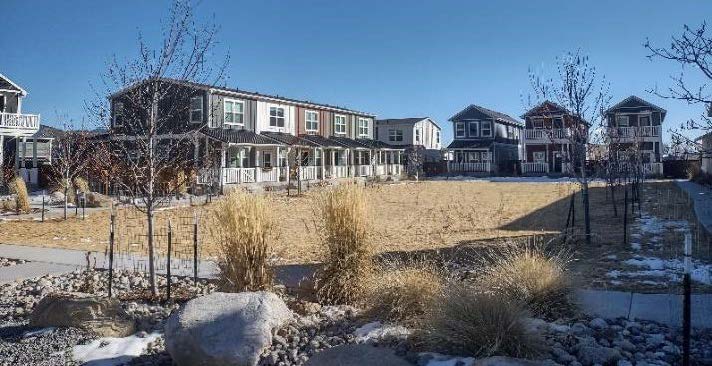Housing Diversity - Case Briefings
Housing Diversity Strategy #1 | Multi-Family Housing Options
A key benefit of allowing different housing types such as duplexes, triplexes, and multi-family housing options as a use by right in traditional single-family zone districts is that implementation of these unit types can be done administratively rather than on a case-by-case basis. These housing types can provide affordable housing options within existing residential areas and help create a more diverse neighborhood.
The highlighted case studies showcase successful instances where communities modified local policies and regulations to encourage higher residential densities and offer a larger range of housing options for residents.
Urban Community Example
Bucking Horse, Fort Collins, Colorado
Located in eastern Fort Collins, Bucking Horse is an example of a mixed housing development consisting of duplexes, triplexes, and multi-family apartment housing options integrated into the overall neighborhood framework. This development pattern promotes a mix of for-sale and for-rent housing options that serve market rate, attainable workforce housing and affordable housing for local residents. This development pattern was accomplished by removing zoning barriers and promoting a vision for an inclusive neighborhood.
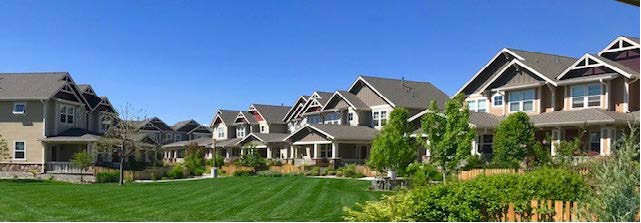
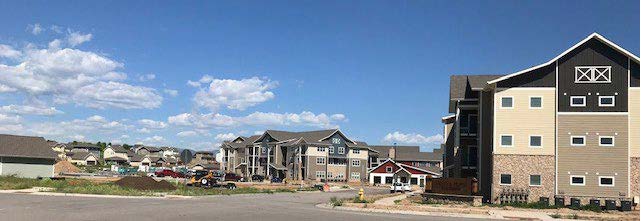
Sources:
Rural Community Example
Telluride Housing Authority sites, Telluride, Colorado
Located in Telluride, these new attainable and affordable housing options were implemented by the local Housing Authority, working closely with the school district, Town of Telluride, and local development/builder community. These sites include a variety of unit types to meet a range of housing needs including apartments, tiny homes, and townhome units. The Shandoka Apartments consist of 134 units, a daycare facility, and laundry facilities. Virginia Placer includes 18 apartments and three tiny homes. Sunnyside Apartments contains 8 townhomes, three tiny homes, 18 apartments, and an in-home daycare facility. The variety of price points and on-site services help to meet local housing needs and serves as a strong model for other communities.
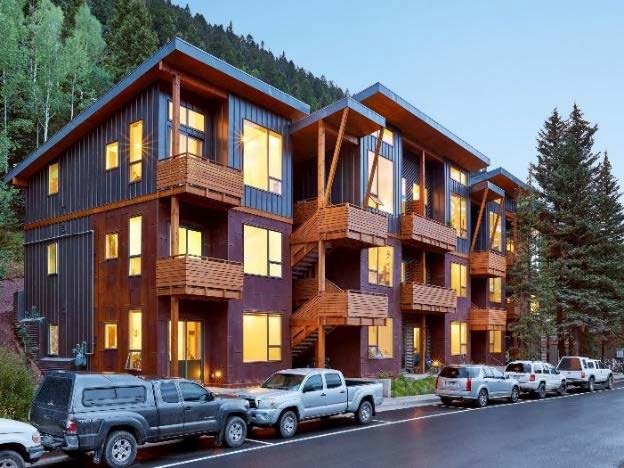
Source:
Housing Diversity Strategy #2 | Accessory Dwelling Units (ADUs)
This strategy focuses on permitting ADUs as a use-by-right in single-family zoning districts. By making these modifications, density is increased without the need for additional infrastructure, while minimizing the impact on neighborhood character. Other key benefits of application include reduced development costs, more affordable housing options within the market, and additional sources of income for property owners. To get started, a community should evaluate their existing regulations to identify barriers to incorporating ADUs. Oftentimes this is found within dimensional criteria for accessory structures, parking requirements, infrastructure and utility connection requirements, and general design criteria. ADUs regulations can be tailored to fit a community by establishing certain baseline requirements that protect existing neighborhoods and reduce potential negative impacts relating to neighborhood context, parking, and utilities.
The highlighted case study showcases a successful instance where modified policies and regulations encourage higher residential densities for affordable and attainable housing in existing residential neighborhoods.
Community Example
ADU Code Amendments, City of Durango, Colorado
 In 2022, Durango adopted code amendments that eased restrictions imposed on new ADUs. With these changes, ADUs are now permitted in all residential neighborhoods in the city limits, except for a few planned development zones. In addition to the adjusted code standards, the city is taking a modified position towards permitting ADUs in neighborhoods with protective covenants. Based on a need for new housing units in the community, property owners in the neighborhoods with covenants that may otherwise prohibit ADUs may now seek approval from the city for ADUs. This policy change enables the city to accept applications for new or pre-existing ADUs in areas previously deemed ineligible to apply.
In 2022, Durango adopted code amendments that eased restrictions imposed on new ADUs. With these changes, ADUs are now permitted in all residential neighborhoods in the city limits, except for a few planned development zones. In addition to the adjusted code standards, the city is taking a modified position towards permitting ADUs in neighborhoods with protective covenants. Based on a need for new housing units in the community, property owners in the neighborhoods with covenants that may otherwise prohibit ADUs may now seek approval from the city for ADUs. This policy change enables the city to accept applications for new or pre-existing ADUs in areas previously deemed ineligible to apply.
Additionally, the city is piloting a program offering financial incentives to property owners who construct an ADU and commit to renting it to a member of the local workforce. The program is limited to an $8,000 rebate for the first 10 new ADU projects. Criteria is in place and can be found at the city’s website listed below.

Source: City of Durango ADU Program
Housing Diversity Strategy #3 | Alternative Building Options
This strategy explores alternative and innovative building options that can help address localized challenges in promoting and developing affordable and attainable housing. These local challenges may include labor shortages, available resources and supplies, general costs, or unknown challenges such as weather or market conditions. Modular home construction, tiny home considerations, 3D printed homes, shipping container homes, and other innovative practices could help in addressing local challenges. The two topic areas highlighted include tiny homes and modular home construction.
Tiny homes could be constructed by a savvy do-it-yourselfer (DIY-er) with professional support and require fewer building materials that result in an overall low cost and entry home option. Unfortunately, many local regulations and policies preclude tiny home development. Zoning criteria needs to be evaluated and adopted that would allow tiny home construction pertaining to lot and site development criteria, as well as allowable uses as tiny homes are often not specified or grouped with mobile homes and RVs.
Modular home construction, which is different from manufactured/trailer homes, can help address labor shortages in rural areas by standardizing construction to improve efficiency. Local regulations often need to be updated to remove prohibitions on modular housing construction, often listed under definitions and zoning uses. The next step is to review and update lot dimension criteria to accommodate various product types and sizes to fit local context and needs, as well as available product types from modular factories.
The benefits of these approaches are to improve cost effectiveness, development turnaround, and improve control over the construction development process. It is important to note that not all innovative or new alternative options are more cost effective. The impact can vary based on a variety of factors, such as location and housing needs.
Rural Community Example
The Farm at Buena Vista, Buena Vista, Colorado
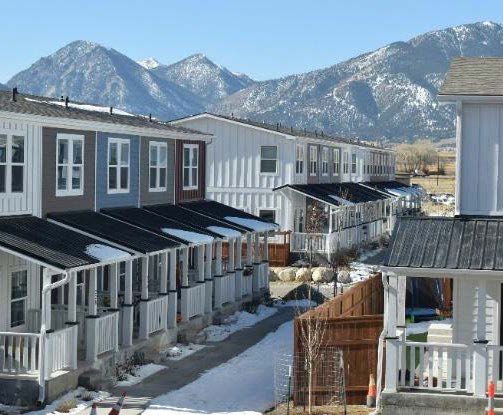 Located in Buena Vista, this development seeks to improve housing options for those in this community. Fading West’s first development, The Farm offers a range of housing products from attached and detached single-family homes as well as a planned 107-unit apartment project. Multiple "pocket parks" offer shared green spaces with amenities throughout the neighborhood. Located minutes from Historic East Main Street, South Main, and the Arkansas River corridor, this close-knit neighborhood features contemporary farmhouse architecture through its’ modular home product offerings. This neighborhood is located east of Fading West’s current Colorado factory where homes are constructed in modular units and installed on foundations on-site. Units can be stacked and oriented in a variety of ways to create variety and to meet local architectural requirements with porches, canopies, windows, and door openings.
Located in Buena Vista, this development seeks to improve housing options for those in this community. Fading West’s first development, The Farm offers a range of housing products from attached and detached single-family homes as well as a planned 107-unit apartment project. Multiple "pocket parks" offer shared green spaces with amenities throughout the neighborhood. Located minutes from Historic East Main Street, South Main, and the Arkansas River corridor, this close-knit neighborhood features contemporary farmhouse architecture through its’ modular home product offerings. This neighborhood is located east of Fading West’s current Colorado factory where homes are constructed in modular units and installed on foundations on-site. Units can be stacked and oriented in a variety of ways to create variety and to meet local architectural requirements with porches, canopies, windows, and door openings.
Source: Fading West Development